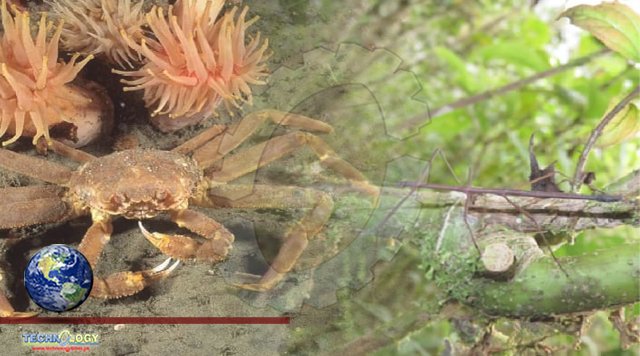Ancient Crab, Imagine a creature shaped somewhat like a toilet brush scuttling along the seafloor around 500 million years ago, near what is now southwestern China.

Now picture that toilet brush with eyes bobbing on stalks; a pair of spike-lined armlike appendages; and a tail fan with long, sweeping blades, and you’ll have a pretty good image of a newly described animal weirdo that lived during the Cambrian period (541 million to 485.4 million years ago). Scientists found the fossil specimens – one of which was a near-complete youngster – in 1990 in the Chengjiang Lagerstätte, a site in China’s Yunnan province. The juvenile individual measured nearly 6 inches (15 centimeters) long and about 2 inches (5 cm) wide, and belongs to a group of extinct ocean-dwelling ancestral arthropods called radiodonts, researchers reported Sept. 7 in the Journal of the Geological Society. Initially, researchers identified the oddball animal as a previously known radiodont species. (The group gets its name from the circular ring of teeth surrounding the animals’ mouths.)Ancient Crab, However, the fossil’s frontmost pair of spiky limbs – known as raptorial appendages – differed from all other radiodonts’, which led to a recent reevaluation of the fossils, said lead study author Han Zeng, an assistant professor at the Nanjing Institute of Geology and Paleontology at the Chinese Academy of Sciences. They dubbed the strange species Innovatiocaris maotianshanensis, with the genus name coming from the Latin words for “innovation” and “crab” and the species name referencing Maotianshan, the location in Chengjiang where the fossils were discovered, according to the study.
When it lived, the species was one of the ocean’s most fearsome predators; in fact, radiodonts are among the oldest giant apex predators on Earth, Zeng said. “Their appearance in the ~520 million-years-ago early Cambrian indicated the formation of complex food webs and marine ecosystems,” he explained. “Besides their ecological importance, Radiodonta have a very bizarre morphology that has puzzled scientists for over a century since their first fossil discoveries in [the] 1880s.” Radiodonts are shaped so strangely that, for decades, their isolated body parts were identified by paleontologists as belonging to a wide range of animal groups. Some of this newly described animal’s unusual radiodont relatives had backward-facing mouths and claw-tipped trunks, while others looked like the Millennium Falcon in the Star Wars movies or sucked up prey like a Roomba. It wasn’t until the 1980s, when scientists found the first complete radiodont fossils, that researchers finally resolved their classification of the group “as an ancestral lineage of arthropods,” Ancient Crab, Zeng said. In I. maotianshanensis, “the spinous raptorial appendages indicate predation of relatively large prey,” while its large eyes hint that it had good vision, Zeng said. Gills and flaps along its trunk were probably used for breathing and swimming, while tail structures helped it turn and maneuver.
Source: This news is originally published by sciencealert